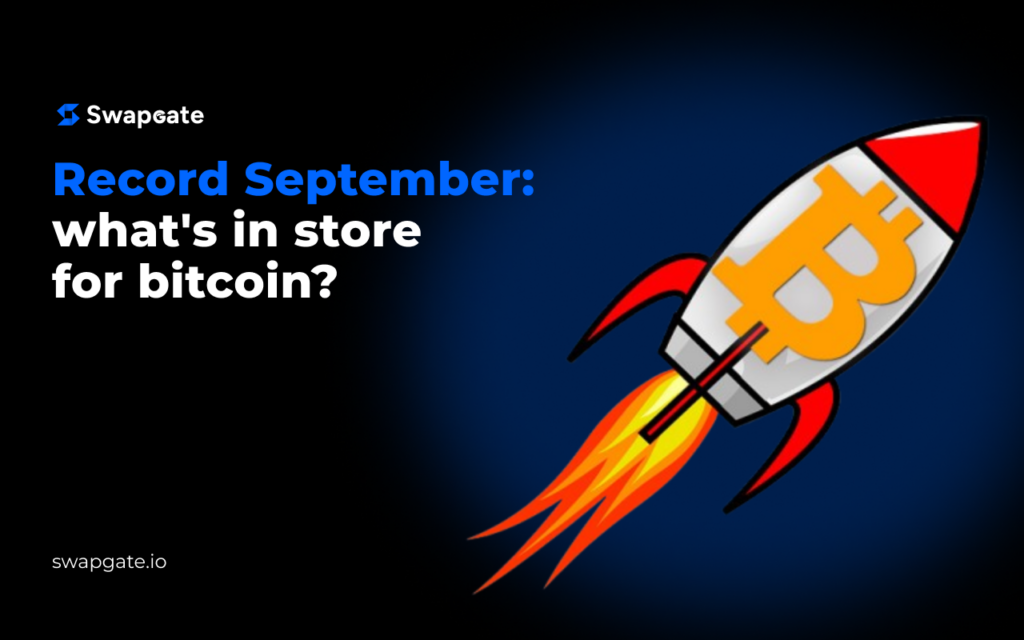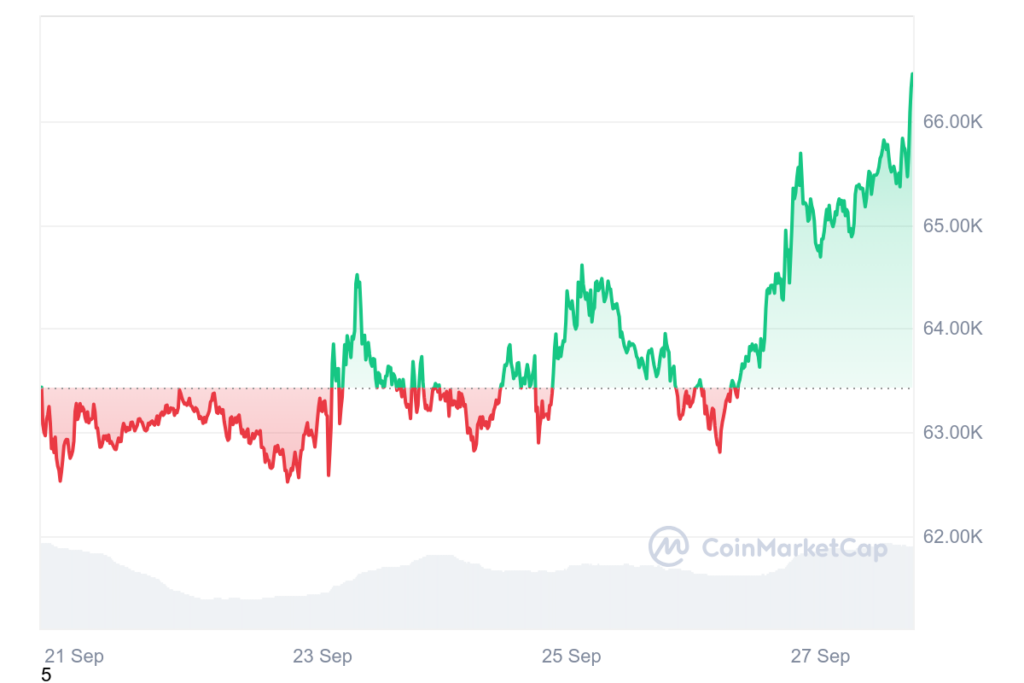
Bitcoin has long been regarded as a volatile asset, but September 2024 delivered an unexpected surprise to investors. The price of the leading cryptocurrency showed steady growth, despite analysts’ forecasts of a potential correction. So, what triggered this rise? In this article, we will conduct a deep analysis of the factors that influenced Bitcoin price dynamics in September and try to predict further developments.
September Surprises: Bitcoin Rises Against Expectations
September 2024 became a true surprise for the cryptocurrency market. While many analysts were predicting the traditional autumn decline in Bitcoin’s price, the flagship cryptocurrency posted an impressive surge, surpassing the $65,000 mark. This was a significant event, especially in light of historical data indicating that September had often been a correction month for Bitcoin.
Historically, September has often been a period of instability and declining value for Bitcoin. Over the past five years, with the exception of 2021, which saw a slight increase, September data has typically shown a correction trend. However, the situation changed dramatically in 2024.
So, what was the reason for this unexpected rally? To answer this, we need to dive deeper into the factors that may have influenced Bitcoin’s price dynamics in September.
One of the key factors is undoubtedly the shift in investor sentiment. Sentiment indicators and the Fear and Greed Index show a clear dominance of bullish attitudes. Investors are increasingly confident in Bitcoin’s long-term prospects, which is reflected in its price.
In addition, external factors may have contributed to Bitcoin’s price growth. Positive economic news, easing monetary policies by central banks, and the anticipation of the U.S. election results could have provided additional support to the cryptocurrency market.
Bitcoin Technical Analysis
It’s also worth noting the technical analysis. On Bitcoin’s weekly chart, the formation of a flag pattern suggests a continuation of the upward trend. This supports the assumption that the current growth is not random and could persist in the near future.
However, despite the impressive performance, it is important to remember that the cryptocurrency market remains highly volatile. Any unforeseen events, such as changes in regulatory policies or geopolitical shocks, could lead to sharp fluctuations in Bitcoin’s price.
In conclusion, September 2024 was a landmark month for Bitcoin. Despite historical data pointing to seasonal weakness, the leading cryptocurrency posted impressive gains. This suggests that Bitcoin is increasingly solidifying its position as a reliable asset, attracting more and more investors.
How Much Does Bitcoin Cost Today?
Currently, the price of Bitcoin stands at $66,186. Some experts have doubts about BTC—whether it will hold this level or if Bitcoin’s price will pull back. Either way, thanks to institutional investors and news buzz, the price is unlikely to drop significantly. The current Bitcoin price is:

With the help of a dynamic widget, you can always find out how much Bitcoin costs today:
Bitcoin: A Brief Overview of History and Basics
Bitcoin is a pioneer in the world of cryptocurrencies. It was created in 2008 by an unknown person or group under the pseudonym Satoshi Nakamoto. Unlike traditional currencies, Bitcoin’s issuance is not controlled by central banks but is regulated by mathematical algorithms embedded in the blockchain protocol.
At the heart of Bitcoin lies the blockchain—a distributed database that stores information about all transactions. Each block in the chain contains information about the previous block, making it almost impossible to falsify. Thanks to this technology, Bitcoin provides the decentralization, security, and transparency that the community needs.
The Creation and Development of Bitcoin
Bitcoin’s journey began with the publication of Satoshi Nakamoto’s “White Paper,” which laid out the basic principles of this new digital currency. In 2009, the first Bitcoin blockchain network was launched, marking the beginning of the entire industry. Remarkably, even after all these years, the identity of Bitcoin’s creator remains a mystery.
Initially, Bitcoin was little known and mainly used in niche circles of enthusiasts. However, over time, interest in the cryptocurrency grew, and its value began to soar. In 2017, a major boom occurred when Bitcoin reached an all-time high price.
Bitcoin’s Advantages and Disadvantages
Bitcoin has several advantages that have made it popular:
- Decentralization: The lack of a central bank protects Bitcoin from inflation and political manipulation.
- Security: Thanks to the blockchain, transactions are nearly impossible to reverse or counterfeit.
- Anonymity: While every transaction is recorded on the blockchain, identifying participants is difficult.
- Global Reach: Bitcoin can be used anywhere in the world where there is internet access.
However, Bitcoin has its drawbacks:
- High Volatility: Bitcoin’s price can fluctuate dramatically in a short period.
- Limited Scalability: The Bitcoin network can process a limited number of transactions per second.
- Energy Consumption: The process of mining Bitcoin requires significant computing power and consumes a lot of electricity.
Bitcoin pioneered the world of cryptocurrencies and laid the foundation for the development of the entire sector. Despite its shortcomings, Bitcoin remains the most popular and discussed digital currency in the world.
Why Do Investors Believe in Bitcoin?
One of the key factors attracting investors to Bitcoin is its limited supply. Unlike fiat currencies, which central banks can issue in unlimited amounts, BTC is capped at 21 million coins. This scarcity may drive up its value over time.
Another mechanism supporting Bitcoin’s deflationary nature is halving. Every four years, the reward for mining new blocks is cut in half, creating artificial scarcity and driving up demand.
Additionally, investors view Bitcoin as a hedge against the devaluation of traditional currencies. Recent financial crises have eroded trust in traditional institutions, and Bitcoin offers an alternative, allowing individuals to manage their finances independently.
Large companies, investment funds, and pension funds are increasingly interested in Bitcoin. Their entry into the market adds stability and legitimacy. Bitcoin is also seen as a new asset class that can help diversify portfolios and reduce risks.
Conclusion
Bitcoin is undoubtedly one of the most discussed and controversial assets of our time. Its history, technology, and potential attract millions of investors worldwide. The current answer to “how much does Bitcoin price” can now be found in our article thanks to the embedded widget.
However, before investing in Bitcoin, it’s essential to weigh all the pros and cons carefully. The cryptocurrency market remains highly volatile, and Bitcoin’s price can change rapidly due to various factors.